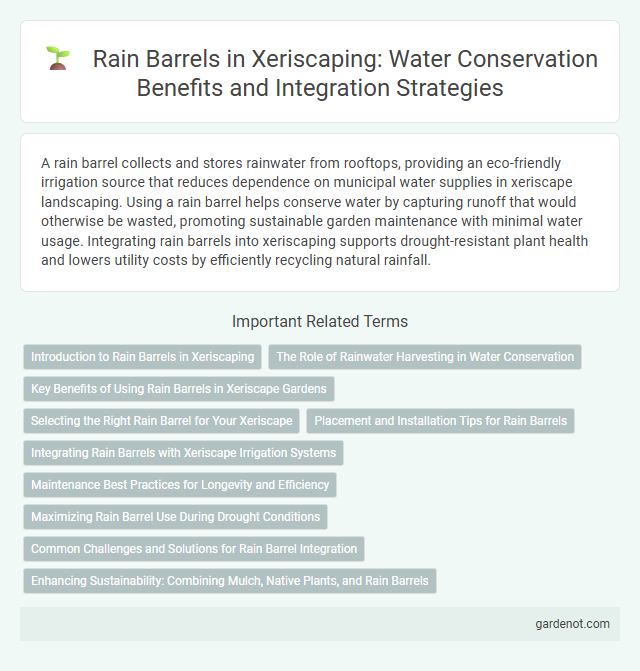A rain barrel collects and stores rainwater from rooftops, providing an eco-friendly irrigation source that reduces dependence on municipal water supplies in xeriscape landscaping. Using a rain barrel helps conserve water by capturing runoff that would otherwise be wasted, promoting sustainable garden maintenance with minimal water usage. Integrating rain barrels into xeriscaping supports drought-resistant plant health and lowers utility costs by efficiently recycling natural rainfall.
Introduction to Rain Barrels in Xeriscaping
Rain barrels play a crucial role in xeriscaping by capturing and storing rainwater from rooftops for later use in irrigation, reducing reliance on municipal water supplies. These water-saving devices help conserve resources and promote sustainable landscaping practices by providing a free, natural water source during dry periods. Properly installed rain barrels optimize water collection efficiency, minimize runoff, and support drought-resistant plant health in xeriscaped yards.
The Role of Rainwater Harvesting in Water Conservation
Rain barrels play a crucial role in rainwater harvesting, significantly reducing dependence on municipal water supplies for landscape irrigation. By capturing and storing runoff from roofs, rain barrels provide an efficient, sustainable water source that conserves potable water and lowers utility costs. Integrating rain barrels into xeriscape designs enhances drought resilience and supports sustainable water management in arid and semi-arid regions.
Key Benefits of Using Rain Barrels in Xeriscape Gardens
Rain barrels capture and store rainwater, reducing reliance on municipal water supplies and lowering water bills in xeriscape gardens. Utilizing stored rainwater supports sustainable water management by conserving natural resources and minimizing runoff that can cause erosion and pollution. Harvested rainwater is typically free of salts and chemicals found in tap water, promoting healthier soil and plants within drought-tolerant xeriscape landscapes.
Selecting the Right Rain Barrel for Your Xeriscape
Selecting the right rain barrel for your xeriscape involves choosing a size that effectively captures sufficient water to meet your landscape's irrigation needs while fitting the available space. Look for rain barrels made from durable, UV-resistant materials to ensure longevity and prevent algae growth, and prioritize models with screened openings to keep debris and insects out. Incorporate features such as spigots for easy water access and overflow valves to manage excess rainfall efficiently in your water-wise xeriscape garden.
Placement and Installation Tips for Rain Barrels
Position rain barrels near downspouts to efficiently capture roof runoff and reduce water waste. Ensure a stable, level surface for installation, such as a concrete pad or sturdy stand, to support the barrel's weight when full. Install a screen or filter at the inlet to prevent debris and insects from entering, and incorporate an overflow valve to manage excess water during heavy rains.
Integrating Rain Barrels with Xeriscape Irrigation Systems
Integrating rain barrels with xeriscape irrigation systems enhances water conservation by capturing and storing rainwater for landscape use, reducing reliance on municipal water sources. Proper placement of rain barrels near downspouts and efficient connection to drip irrigation or soaker hoses ensures precise water delivery to drought-tolerant plants, improving soil moisture retention. This sustainable approach synergizes with xeriscape principles, optimizing water efficiency and promoting resilient, low-maintenance landscaping.
Maintenance Best Practices for Longevity and Efficiency
Regular cleaning of rain barrels prevents clogging and ensures efficient water collection, while inspecting seals and fittings helps avoid leaks and contamination. Using fine mesh screens on inlets keeps debris and insects out, enhancing water quality and barrel durability. Draining the barrel before freezing temperatures prevents cracking, significantly extending the lifespan of rainwater harvesting systems in xeriscape gardens.
Maximizing Rain Barrel Use During Drought Conditions
Rain barrels capture and store rainwater from rooftops, providing a sustainable water source during drought conditions and reducing reliance on municipal water supplies. Properly placed and connected rain barrels can maximize water collection efficiency, enabling homeowners to irrigate xeriscape gardens with minimal waste. Using rain barrel water for drought-resistant plants supports conservation efforts and maintains healthy landscaping despite water restrictions.
Common Challenges and Solutions for Rain Barrel Integration
Rain barrel integration in xeriscaping faces challenges such as overflow during heavy rain, sediment buildup, and limited storage capacity. Installing an overflow diversion system helps prevent flooding by redirecting excess water, while regular cleaning of filters and screens reduces sediment accumulation. Using multiple barrels or larger capacity units ensures adequate water storage for efficient irrigation during dry periods.
Enhancing Sustainability: Combining Mulch, Native Plants, and Rain Barrels
Rain barrels play a crucial role in xeriscaping by capturing and storing rainwater for irrigation, significantly reducing reliance on municipal water supplies. When combined with mulch and drought-tolerant native plants, rain barrels enhance soil moisture retention and minimize evaporation, promoting sustainable water use. This integrated approach supports resilient landscapes that conserve water and thrive in arid environments.
Rain barrel Infographic

 gardenot.com
gardenot.com